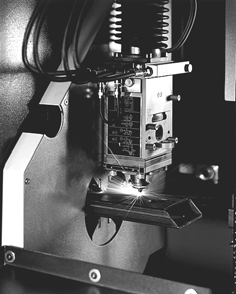Laser for Motion System
The fact that the laser beam, as a tool, requires no mechanical contact with the workpiece, and may therefore be considered a non-contact tool, opens up a score of possibilities to position the tool and the component relative to each other.
The simplest concept involves a stationary workpiece and a stationary laser beam.
This concept is encountered, for instance, in laboratory set-ups for spot welding with manual loading and unloading of the workpiece.
If motion systems are required, however, the corresponding installations are categorized by their freedom of movement in space.
1D systems include all those allowing processing in one direction or along one axis only, for example systems for pipes, profiles, or strips. It is usually the machining head that is stationary, though these systems are frequently equipped with additional linear positioning axes in the machining head. This is needed to achieve the required tolerances, for such as welding (see sensors).
2D systems are used primarily for plane sheet metal processing. Although, 2D systems targeted for cutting or welding are gaining importance for the processing of complex pipes and profiles, too.
There are machine concepts based on moving either the machining head or the workpiece, as well as systems involving a combination of both.

The principle of moving the machining head offers the advantage of having to move only lightweight components. The negligible inertia of the beam delivery components (e.g., moving mirrors in a ”flying optics system“) allows rapid speeds and accelerations with high accuracy and repeatability. The high mass inertia of mobile systems, on the other hand, causes inaccuracies, giving rise to vibrations during linear acceleration.
High accelerations are particularly important for complicated contours. The best results are obtained with CNC systems equipped with linearmotor powered axial drives. The precision obtained from commercially available robots is not always sufficient for these purposes.
For three-dimensional processing of sheet metals, 5-axis gantry systems or 7-axis robot systems, are used. Recently, Remote Welding Systems have also been introduced. Positioning, together with gantry systems, is affected by three linear axes oriented perpendicularly to each other. Semi-flying optical systems are frequently used in this context; i.e., the optics are moved along two axes while the workpiece travels along one axis on a carriage. To ensure a perfectly perpendicular laser beam angle on the workpiece surface, gantry systems are also equipped with two rotational axes for laser head positioning.
Along with the processing of three-dimensional sheet metal parts, e.g., automotive bodies, robot systems may offer a financially attractive alternative to gantry systems.
Depending on the contours to be processed, it is important to decide whether or not a robot solution affords the necessary processing precision and if it has the required dynamic properties. In the case of solid-state lasers, the machining head is being guided by the robot and supplied with laser light by an externally suspended optical fiber.
With diode lasers, the robot may also position the laser directly on the workpiece. Articulated-arm laser beam guidance, as described above, is an asset in the design of CO2 laser systems with industrial robots.
